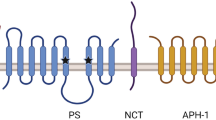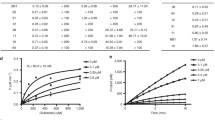Abstract
The discovery that β-secretase is a membrane-anchored aspartic protease memapsin 2 has stimulated much interest in the design and testing of its inhibitors for the treatment of Alzheimer’s disease. This article discusses the strategy for the development of such inhibitor drugs. Enzymology and structural determination tools have permitted the design of memapsin 2 inhibitors with high potency and in a size range possible for penetration of the blood-brain barrier. Transgenic Alzheimer’s mice have been used to show that when memapsin 2 inhibitors are transported to the brain, they effectively reduce the production of amyloid β. Although development of a clinical candidate of memapsin 2 inhibitor drug remains a very challenging undertaking, the progress so far lends some optimism for future prospects.
Similar content being viewed by others
References
Cai H., Wang Y., McCarthy D., Wen H., Borchelt D. R., Price D. L., and Wong P. C. (2001) BACE1 is the major beta-secretase for generation of Aβ peptides by neurons. Nat. Neurosci. 4, 233–234.
Chang W. P., Downs D., Tang J., Koelsch G., and Ghosh A. (2002) In vivo inhibition of Aβ production by memapsin 2 (β-secretase) inhibitors. Abstracts of the Eighth International Conference on Alzheimer’s Disease and Related Disorders, July 20–25, Stockholm, Sweden.
Chang W. P., Koelsch G., Down D., Weerasena V., Wong S., Ghosh A., and Tang J. (2003) In vivo inhibition of Aβ production by memapsin 2 (β-secretase) inhibitors, in preparation.
Ermolieff J., Loy J. A., Koelsch G., and Tang J. (2000) Proteolytic activation of recombinant pro-memapsin 2 (pro-β-secretase) studied with new fluorogenic substrates. Biochemistry 39, 12,450–12,456.
Farzan M., Schnitzler C. E., Vasilieva N., Leung D., and Choe H. (2000) BACE2, a β-secretase homolog, cleaves at the beta site and within the amyloid-β region of the amyloid-beta precursor protein. Proc. Natl. Acad. Sci. USA 97, 9712–9717.
Fluhrer R., Capell A., Westmeyer G., et al. (2002) A non-amyloidogenic function of BACE-2 in the secretory pathway. J. Neurochem. 81, 1001–1020.
Ghosh A. K., Shin D., Downs D., Koelsch G., Lin X., Ermolieff J., and Tang J. (2000) Design of potent inhibitors for human brain memapsin 2 (β-secretase). J. Am. Chem. Soc. 122, 3522–3523.
Ghosh A. K., Bilcer G., Harwood C., Kawahama R., Shin D., Hussain K. A., et al. (2001) Structure-based design: potent inhibitors of human memapsin 2 (β-secretase). J. Med. Chem. 44, 2865–2868.
Hong L., Koelsch G., Lin X., Wu S., Terzyan S., Ghosh A. K., et al. (2000) Structure of the protease domain of memapsin 2 (β-secretase) complexed with inhibitor. Science 290, 150–153.
Hong L., Turner R. T., Koelsch G., Shin D., Ghosh A. K., and Tang J. (2002) Crystal structure of memapsin 2 (beta-secretase) in complex with an inhibitor OM00-3. Biochemistry 41, 10,963–10,967.
Lin X., Koelsch G., Wu S., Downs D., Dashti A., and Tang J. (2000) Human aspartic protease memapsin 2 cleaves the β-secretase site of β-amyloid precursor protein. Proc. Natl. Acad. Sci. USA 97, 1456–1460.
Luo Y., Bolon B., Kahn S., Bennett B. D., Babu-Khan S., Denis P., et al. (2001) Mice deficient in BACE1, the Alzheimer’s β-secretase, have normal phenotype and abolished β-amyloid generation. Nat. Neurosci. 4, 231–232.
Martin C., Sonnerborg A., Svensson J. O., and Stahle L. (1999) Indinavir-based treatment of HIV-1 infected patients: efficacy in the central nervous system. AIDS 13, 1227–1232.
Roberds S. L., Anderson J., Basi G., Bienkowski M. J., et al. (2001) BACE knockout mice are healthy despite lacking the primary β-secretase activity in brain: implications for Alzheimer’s disease therapeutics. Hum. Mol. Genet. 10, 1317–1324.
Selkoe D. J. (1999) Translating cell biology into therapeutic advances in Alzheimer’s disease. Nature 399A, 23–31.
Turner R. T., Koelsch G., Hong L., Castenheira P., Ghosh A., and Tang J. (2001) Subsite specificity of memapsin 2 (β-secretase): implications for inhibitor design. Biochemistry 40, 10,001–10,006.
Turner R. T., Loy J. A., Nguyen C., Devasamudram T., Ghosh A. K., and Tang J. (2002) Specificity of memapsin 1 and its implications on the design of memapsin 2 β-secretase) inhibitor selectivity. Biochemistry 41, 8742–8746.
Author information
Authors and Affiliations
Corresponding author
Rights and permissions
About this article
Cite this article
Tang, J., Ghosh, A.K., Hong, L. et al. Study of memapsin 2 (β-secretase) and strategy of inhibitor design. J Mol Neurosci 20, 299–304 (2003). https://doi.org/10.1385/JMN:20:3:299
Received:
Accepted:
Issue Date:
DOI: https://doi.org/10.1385/JMN:20:3:299




